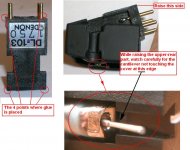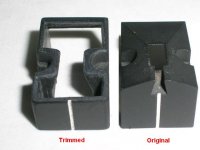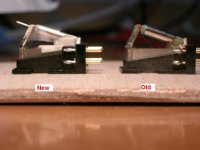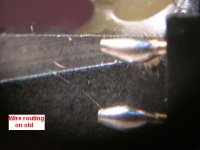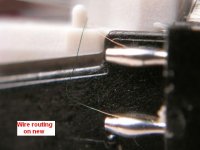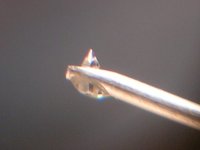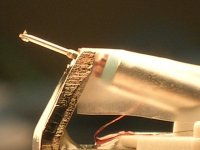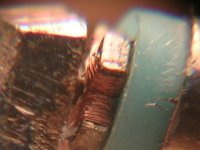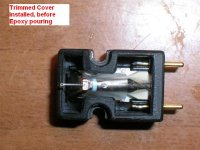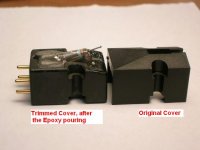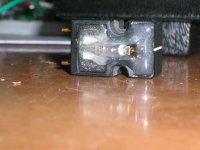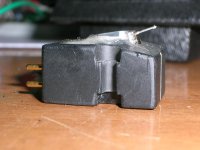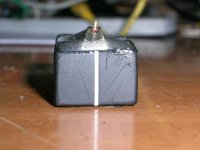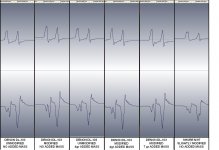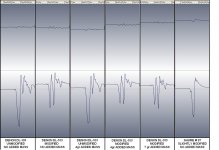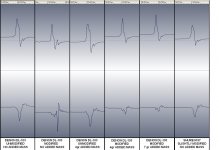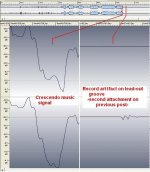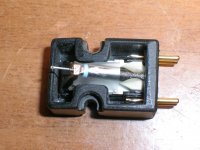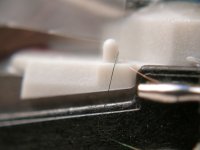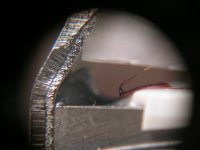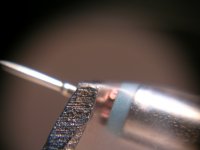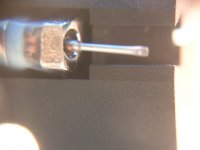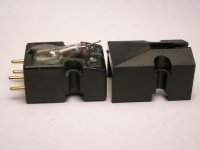A friend of mine called me one day telling me that his old DL-103 had one channel dead, producing only 50HZ noise. He brought the turntable home and found that the problem was on the cartridge.
I told him that I will try to open it up and see if I can repair it, but chances are that I may damage it in the process and he should consider buying a new one.
He said go ahead, it’s dead to me already.
Well, in the process of opening the cartridge body, I managed to brake the cantilever right from the start ! So I ordered a new one for him and, as I had read so many good opinions about this cartridge, I ordered one for me too.
I spent some time with the damaged cartridge experimenting how one could remove the plastic body without braking the cantilever.
It takes a scissor to separate the top and rear side -on which the motor is glued with epoxy - from the rest plastic cover. The cover is glued to four points with a soft glue (something like benzene glue).
Then I looked why one channel was dead. I found that one of the four coil wires was cut due to rubbing on a sharp edge of the magnet.
There are a lot of cartridge body alterations on the internet for the DENON DL-103, all claiming improvement on the sound. The ready made ones cost a lot for me.
When the new cartridges arrived, I was already set to modify mine. So, I opened one of the newcomers and I compared the innards of the new one and the old - some 9 years old - one.
I told him that I will try to open it up and see if I can repair it, but chances are that I may damage it in the process and he should consider buying a new one.
He said go ahead, it’s dead to me already.
Well, in the process of opening the cartridge body, I managed to brake the cantilever right from the start ! So I ordered a new one for him and, as I had read so many good opinions about this cartridge, I ordered one for me too.
I spent some time with the damaged cartridge experimenting how one could remove the plastic body without braking the cantilever.
It takes a scissor to separate the top and rear side -on which the motor is glued with epoxy - from the rest plastic cover. The cover is glued to four points with a soft glue (something like benzene glue).
Then I looked why one channel was dead. I found that one of the four coil wires was cut due to rubbing on a sharp edge of the magnet.
There are a lot of cartridge body alterations on the internet for the DENON DL-103, all claiming improvement on the sound. The ready made ones cost a lot for me.
When the new cartridges arrived, I was already set to modify mine. So, I opened one of the newcomers and I compared the innards of the new one and the old - some 9 years old - one.
Attachments
One can see that there are two areas where differences are visible.
The new one has a cover around the armature/pivot point for to protect this exposed area from debris and dirt .
On the new one, there is a white plastic former with rounded edges that covers the sharp edges of the magnet at the area where the coil wires travel toward the output pins.
The new one has a cover around the armature/pivot point for to protect this exposed area from debris and dirt .
On the new one, there is a white plastic former with rounded edges that covers the sharp edges of the magnet at the area where the coil wires travel toward the output pins.
Attachments
What I saw from opening these unshielded cartridges, is that the “hull” of the body (comprised of the left, right, forward and lower sides) is lightly glued in 4 places with the top and rear sides which carry all the motor assy and the output pins.
In terms of eliminating the various mid and hf resonances of all these parts, I thought that it would be a good thing if I could make all parts acting as a single element, by pouring epoxy inside. From what I have read, this cartridge benefits by loading it with some extra mass (stories go up to 8gr additional mass!) , therefore this extra epoxy mass would do some of this effect as well.
This is an endeavor which is a risky one (these risks are irreversible) .
Risk 1: To brake the cantilever while removing the plastic cover (body).
Risk 2: To let the epoxy flow where it shouldn’t flow , that is, close to the moving parts making them immovable, in contact with the elastomer fitting of the coils altering it’s compliance, and at the free length of the coil wires right as they exit from the coil. This free length has to be able to follow the miniscule movements of the coil, else the fragile wires will brake sometime during playing time.
Risk 3: The damping of the cartridge body may alter the cartridge acoustic signature. In other words, did the Denon engineers had deliberately voiced this cartridge utilizing the body’s sound? In case that such a change is evident, to what extend the sound of the stock unit is better/worse than the modified?
In terms of eliminating the various mid and hf resonances of all these parts, I thought that it would be a good thing if I could make all parts acting as a single element, by pouring epoxy inside. From what I have read, this cartridge benefits by loading it with some extra mass (stories go up to 8gr additional mass!) , therefore this extra epoxy mass would do some of this effect as well.
This is an endeavor which is a risky one (these risks are irreversible) .
Risk 1: To brake the cantilever while removing the plastic cover (body).
Risk 2: To let the epoxy flow where it shouldn’t flow , that is, close to the moving parts making them immovable, in contact with the elastomer fitting of the coils altering it’s compliance, and at the free length of the coil wires right as they exit from the coil. This free length has to be able to follow the miniscule movements of the coil, else the fragile wires will brake sometime during playing time.
Risk 3: The damping of the cartridge body may alter the cartridge acoustic signature. In other words, did the Denon engineers had deliberately voiced this cartridge utilizing the body’s sound? In case that such a change is evident, to what extend the sound of the stock unit is better/worse than the modified?
Attachments
Last edited:
Very informative - thanks for sharing. I have a ZU DL-103 and am thinking about getting another DL-103 or 103R and installing in a Midas body so this is extremely helpful information.
WRT how one of these sounds in a housing made by someone other than Denon (in this case Zu Audio) I can say it is a big improvement. (More detail, less colored, etc.)
WRT how one of these sounds in a housing made by someone other than Denon (in this case Zu Audio) I can say it is a big improvement. (More detail, less colored, etc.)
Last edited:
My hands were itching me, so I bit the bullet and went ahead.
I removed the plastic cover , I trimmed off it’s lower side, I put it back in and filled the whole thing with 2 parts fast curing epoxy in three steps, 2 hours between each step to let it set and take off the heat from the chemical reaction. First, epoxy on the rear side, then on the front and last on the most critical middle part .
I removed the plastic cover , I trimmed off it’s lower side, I put it back in and filled the whole thing with 2 parts fast curing epoxy in three steps, 2 hours between each step to let it set and take off the heat from the chemical reaction. First, epoxy on the rear side, then on the front and last on the most critical middle part .
Attachments
Kevinkr
After finishing the mod, I made some comparative recordings from a record with the original Denon, the modified one and two other cartridges I had, all installed on the same turntable and arm (a direct drive Kenwood), properly adjustment c/out for each one.
After listening to the recordings, my impression was that the modified Denon was somehow sounding as you describe compared to the original.
Subjective opinion I said, but what was more clearly noticed was that the clicks and pops of the record were sounding less objectionable with the modified one, so much that I became curious as to if I could “see” this difference.
I manually synchronized the recordings and took some screenshots from the signals produced by various record surface artefacts.
On the attached screenshots you will see the output of each cartridge.
Each photo, refers to the same artefact. Upper trace is left channel, lower trace is right channel.
I was quite surprised from the differences.
Regards
George
WRT how one of these sounds in a housing made by someone other than Denon (in this case Zu Audio) I can say it is a big improvement. (More detail, less colored, etc.)
After finishing the mod, I made some comparative recordings from a record with the original Denon, the modified one and two other cartridges I had, all installed on the same turntable and arm (a direct drive Kenwood), properly adjustment c/out for each one.
After listening to the recordings, my impression was that the modified Denon was somehow sounding as you describe compared to the original.
Subjective opinion I said, but what was more clearly noticed was that the clicks and pops of the record were sounding less objectionable with the modified one, so much that I became curious as to if I could “see” this difference.
I manually synchronized the recordings and took some screenshots from the signals produced by various record surface artefacts.
On the attached screenshots you will see the output of each cartridge.
Each photo, refers to the same artefact. Upper trace is left channel, lower trace is right channel.
I was quite surprised from the differences.
Regards
George
Attachments
The waveforms shown above have been increased in amplitude for detailed viewing.
They are actually small amplitude signals.
For having a better perspective, the artifact represented in the second attachment above (Denon DL-103 modified no added mass) is shown now on the same amplitude (and time) scale with a music crescendo from the same recording.
According to the recording software, the negative going part of the artifact signal has an amplitude of 11.13db, while that of the crescendo has an amplitude of 93.61db, i.e. artifact level is 82.48dB lower than crescendo level
Regards
George
They are actually small amplitude signals.
For having a better perspective, the artifact represented in the second attachment above (Denon DL-103 modified no added mass) is shown now on the same amplitude (and time) scale with a music crescendo from the same recording.
According to the recording software, the negative going part of the artifact signal has an amplitude of 11.13db, while that of the crescendo has an amplitude of 93.61db, i.e. artifact level is 82.48dB lower than crescendo level
Regards
George
Attachments
Signed up for this form just to view your pix, George. Fabulous detail. Today I can buy an a custom aluminum shell for my 103r for $50, but the process of nudging and potting the cartridge is still risky. Thanks for this generous post.
Thanks.🙂
It was a good experience and I enjoyed the cart much.
If you are going do the mod, notice that the most dangerous step is at the beginning, when removing the cover. Raise the rear side first and then very slowly move the cover forward, watching the cover not to touch the cantilever. (see 1st post, 1st attachment).
The clearance is really small.
If the cover touch the cantilever, the cantilever will brake at the fragile point of diameter change.
That said, if I was to buy another D-103, I would do the same mod on it again
This time pouring epoxy only into the front and the rear cavity, leaving the middle bay (around the attaching bolt holes) dry.
That's much easier, less risky and no difference in effect from the full filling.
George
It was a good experience and I enjoyed the cart much.
If you are going do the mod, notice that the most dangerous step is at the beginning, when removing the cover. Raise the rear side first and then very slowly move the cover forward, watching the cover not to touch the cantilever. (see 1st post, 1st attachment).
The clearance is really small.
If the cover touch the cantilever, the cantilever will brake at the fragile point of diameter change.
That said, if I was to buy another D-103, I would do the same mod on it again
This time pouring epoxy only into the front and the rear cavity, leaving the middle bay (around the attaching bolt holes) dry.
That's much easier, less risky and no difference in effect from the full filling.
George
Attachments
Wow, this place is great. Thanks again George. I bent my 103R cantaliver while trying to adjust vertical tracking force on my Technics 1700mk2. Skidded across the record surface once and that was it! I sent to this fellow for repair and he also denuded it,
so I didn't have to mess with that. My experience with him was great so I can recommend him.
Denon DL-103 and 103R Nude True Ellipsoid Elliptical/Narrow Cantilever Service | eBay
After Xmas I'll pot it into the aluminum shell and try to post pix. My bolt holes are threaded and don't extend all the way through so that should be easier as well.
so I didn't have to mess with that. My experience with him was great so I can recommend him.
Denon DL-103 and 103R Nude True Ellipsoid Elliptical/Narrow Cantilever Service | eBay
After Xmas I'll pot it into the aluminum shell and try to post pix. My bolt holes are threaded and don't extend all the way through so that should be easier as well.
- Status
- Not open for further replies.
- Home
- Source & Line
- Analogue Source
- Modifying a DL-103 (a Nov 2009 story)
